tow VOLKSWAGEN UP! 2021 Owner´s Manual
[x] Cancel search | Manufacturer: VOLKSWAGEN, Model Year: 2021, Model line: UP!, Model: VOLKSWAGEN UP! 2021Pages: 211, PDF Size: 5.98 MB
Page 3 of 211
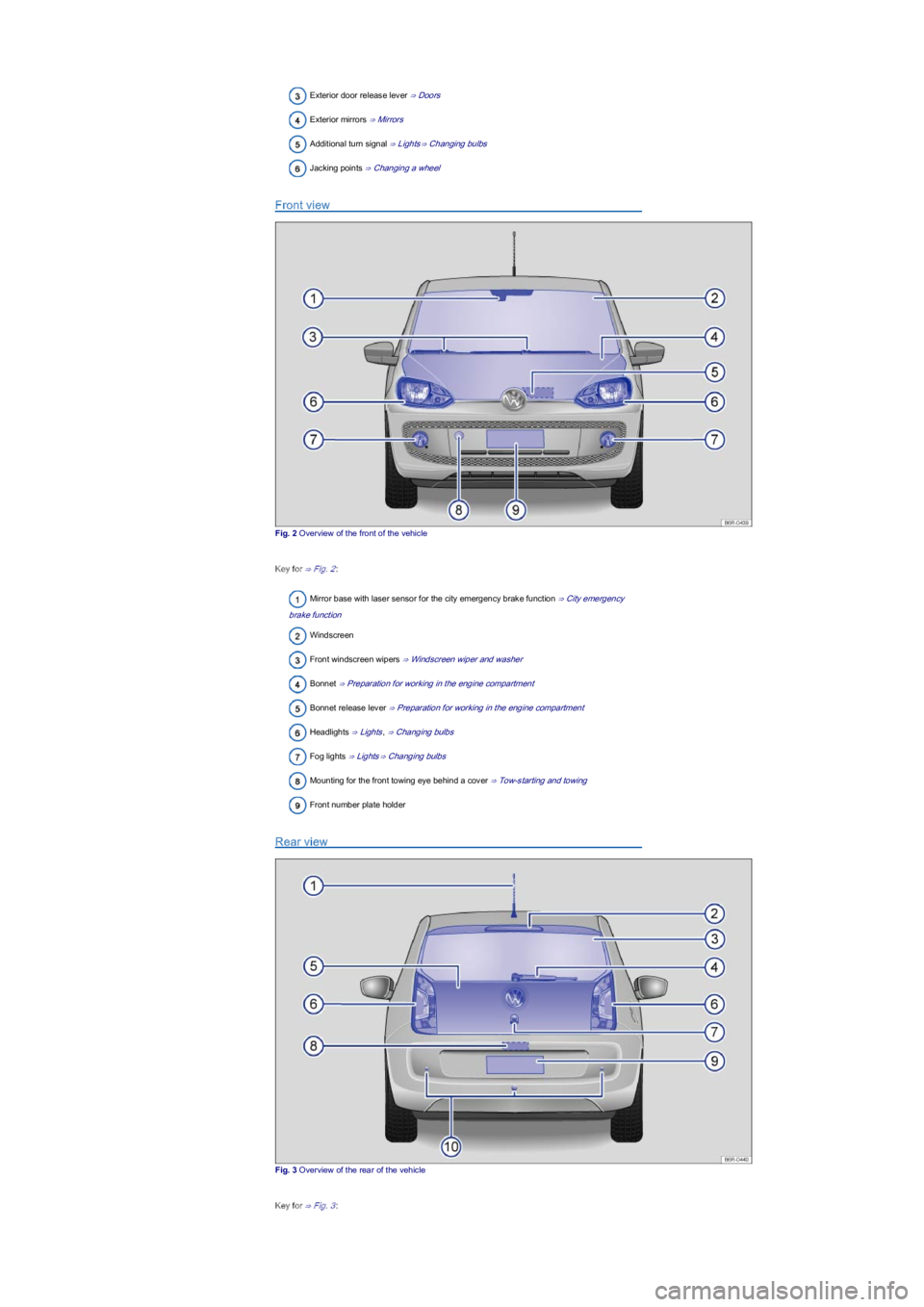
Exterior door release lever ⇒ Doors
Exterior mirrors ⇒ Mirrors
Additional turn signal ⇒ Lights⇒ Changing bulbs
Jacking points ⇒ Changing a wheel
Front view
Fig. 2 Overview of the front of the vehicle
Key for ⇒ Fig. 2:
Mirror base with laser sensor for the city emergency brake function ⇒ City emergency
brake function
Windscreen
Front windscreen wipers ⇒ Windscreen wiper and washer
Bonnet ⇒ Preparation for working in the engine compartment
Bonnet release lever ⇒ Preparation for working in the engine compartment
Headlights ⇒ Lights, ⇒ Changing bulbs
Fog lights ⇒ Lights⇒ Changing bulbs
Mounting for the front towing eye behind a cover ⇒ Tow-starting and towing
Front number plate holder
Rear view
Fig. 3 Overview of the rear of the vehicle
Key for ⇒ Fig. 3:
Page 4 of 211

Roof aerial ⇒ Consumer information
High-mounted brake light
Rear window
- Rear window heating ⇒ Heating, ventilating, cooling
Rear wiper ⇒ Windscreen wiper and washer
Tailgate ⇒ Tailgate
Tail light cluster ⇒ Lights⇒ Changing bulbs
Grip with tailgate release button ⇒ Tailgate
Number plate lights ⇒ Changing bulbs
Rear number plate holder
ParkPilot sensors ⇒ ParkPilot
Vehicle interior
Overview of the driver door
Fig. 4 Overview of the controls in the driver door (left-hand drive vehicles). The controls are
mirrored in right-hand drive vehicles
Key for ⇒ Fig. 4:
Button for operating the electric window in the driver door ⇒ Windows or stowage
compartment ⇒ Stowage area
Door release lever ⇒ Doors
Indicator lamp for SAFELOCK mechanism ⇒ Central locking system
Rotary knob for adjusting the electrical exterior mirrors ⇒ Mirrors
- Exterior mirror setting
- Exterior mirror heating
Central locking button for locking and unlocking the vehicle ⇒ Central locking
system
Handle for releasing the bonnet ⇒ Preparation for working in the engine compartment
Stowage compartment with drink holder ⇒ Stowage area⇒ Drink holder
Other available control elements
Depending on the level of equipment, the vehicle may have manual windows and/or manual
adjustment of the exterior mirrors ⇒ Mirrors.
Overview of the driver side
Page 6 of 211
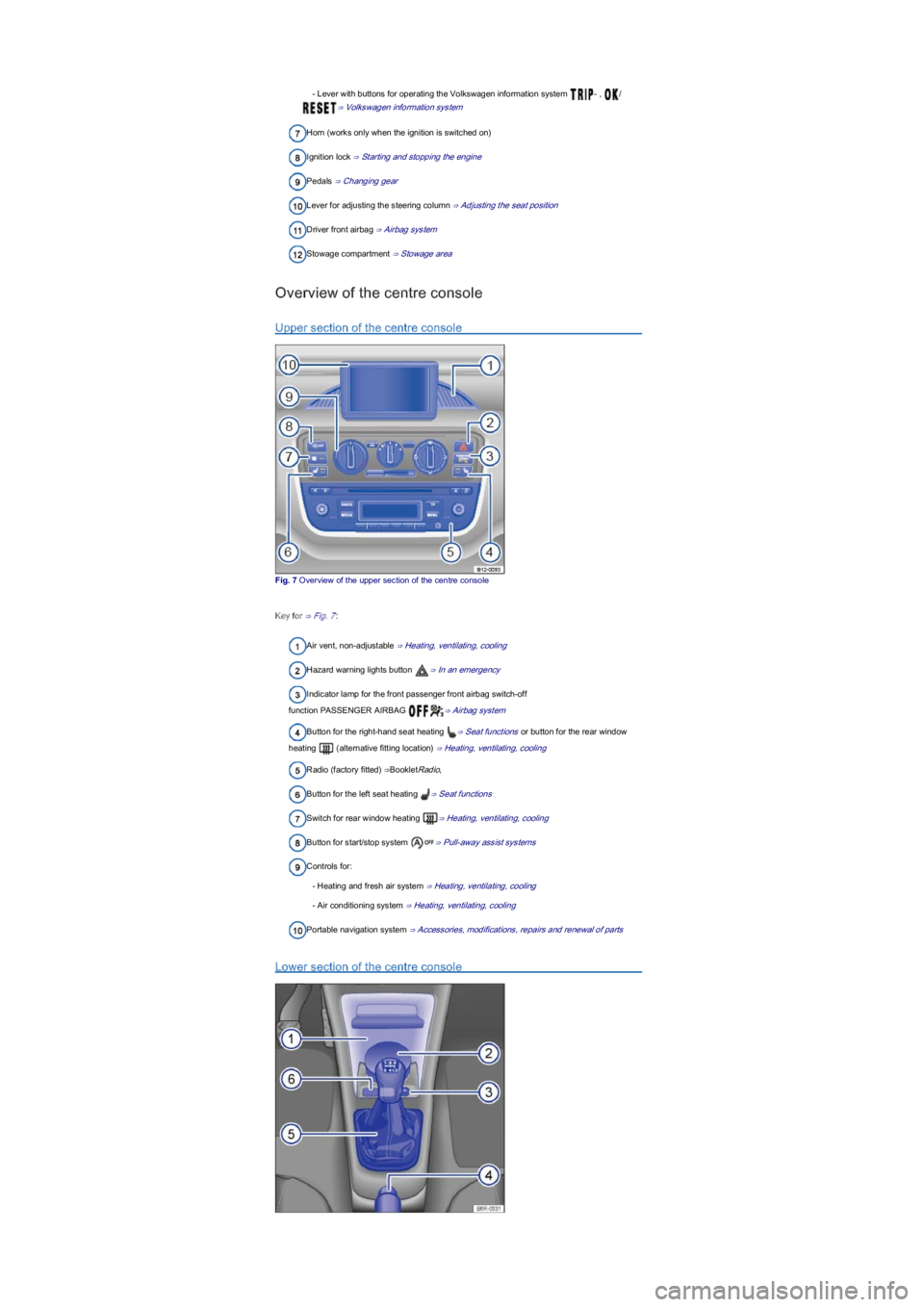
- Lever with buttons for operating the Volkswagen information system - , /
⇒ Volkswagen information system
Horn (works only when the ignition is switched on)
Ignition lock ⇒ Starting and stopping the engine
Pedals ⇒ Changing gear
Lever for adjusting the steering column ⇒ Adjusting the seat position
Driver front airbag ⇒ Airbag system
Stowage compartment ⇒ Stowage area
Overview of the centre console
Upper section of the centre console
Fig. 7 Overview of the upper section of the centre console
Key for ⇒ Fig. 7:
Air vent, non-adjustable ⇒ Heating, ventilating, cooling
Hazard warning lights button ⇒ In an emergency
Indicator lamp for the front passenger front airbag switch-off
function PASSENGER AIRBAG ⇒ Airbag system
Button for the right-hand seat heating ⇒ Seat functions or button for the rear window
heating (alternative fitting location) ⇒ Heating, ventilating, cooling
Radio (factory fitted) ⇒BookletRadio,
Button for the left seat heating ⇒ Seat functions
Switch for rear window heating ⇒ Heating, ventilating, cooling
Button for start/stop system ⇒ Pull-away assist systems
Controls for:
- Heating and fresh air system ⇒ Heating, ventilating, cooling
- Air conditioning system ⇒ Heating, ventilating, cooling
Portable navigation system ⇒ Accessories, modifications, repairs and renewal of parts
Lower section of the centre console
Page 7 of 211
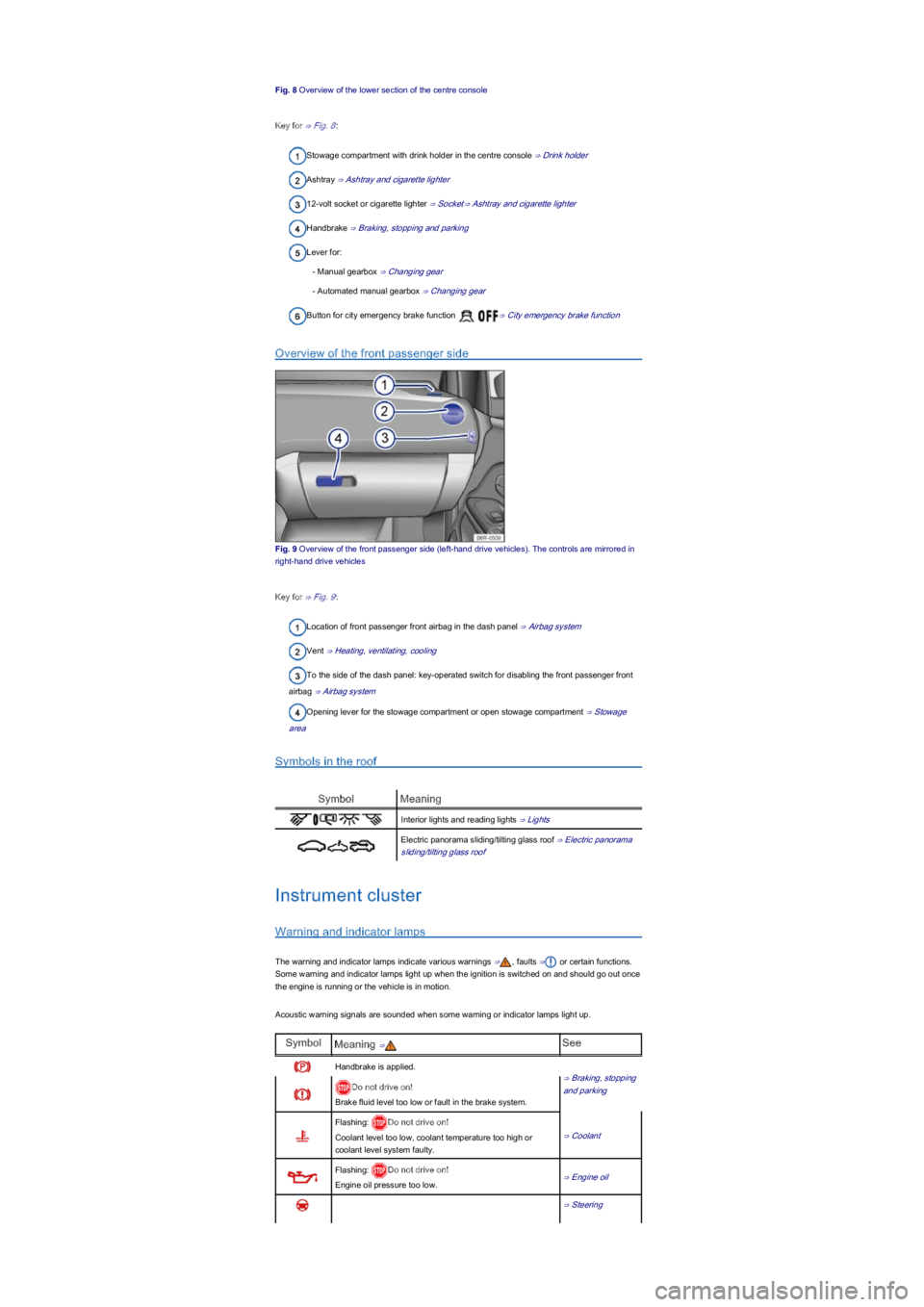
Fig. 8 Overview of the lower section of the centre console
Key for ⇒ Fig. 8:
Stowage compartment with drink holder in the centre console ⇒ Drink holder
Ashtray ⇒ Ashtray and cigarette lighter
12-volt socket or cigarette lighter ⇒ Socket⇒ Ashtray and cigarette lighter
Handbrake ⇒ Braking, stopping and parking
Lever for:
- Manual gearbox ⇒ Changing gear
- Automated manual gearbox ⇒ Changing gear
Button for city emergency brake function ⇒ City emergency brake function
Overview of the front passenger side
Fig. 9 Overview of the front passenger side (left-hand drive vehicles). The controls are mirrored in
right-hand drive vehicles
Key for ⇒ Fig. 9:
Location of front passenger front airbag in the dash panel ⇒ Airbag system
Vent ⇒ Heating, ventilating, cooling
To the side of the dash panel: key-operated switch for disabling the front passenger front
airbag ⇒ Airbag system
Opening lever for the stowage compartment or open stowage compartment ⇒ Stowage
area
Symbols in the roof
SymbolMeaning
Interior lights and reading lights ⇒ Lights
Electric panorama sliding/tilting glass roof ⇒ Electric panorama
sliding/tilting glass roof
Instrument cluster
Warning and indicator lamps
The warning and indicator lamps indicate various warnings ⇒, faults ⇒ or certain functions.
Some warning and indicator lamps light up when the ignition is switched on and should go out once
the engine is running or the vehicle is in motion.
Acoustic warning signals are sounded when some warning or indicator lamps light up.
SymbolMeaning ⇒See
Handbrake is applied.
⇒ Braking, stopping
and parkingDo not drive on!
Brake fluid level too low or fault in the brake system.
Flashing: Do not drive on!
Coolant level too low, coolant temperature too high or
coolant level system faulty.
⇒ Coolant
Flashing: Do not drive on!
Engine oil pressure too low.⇒ Engine oil
⇒ Steering
Page 15 of 211
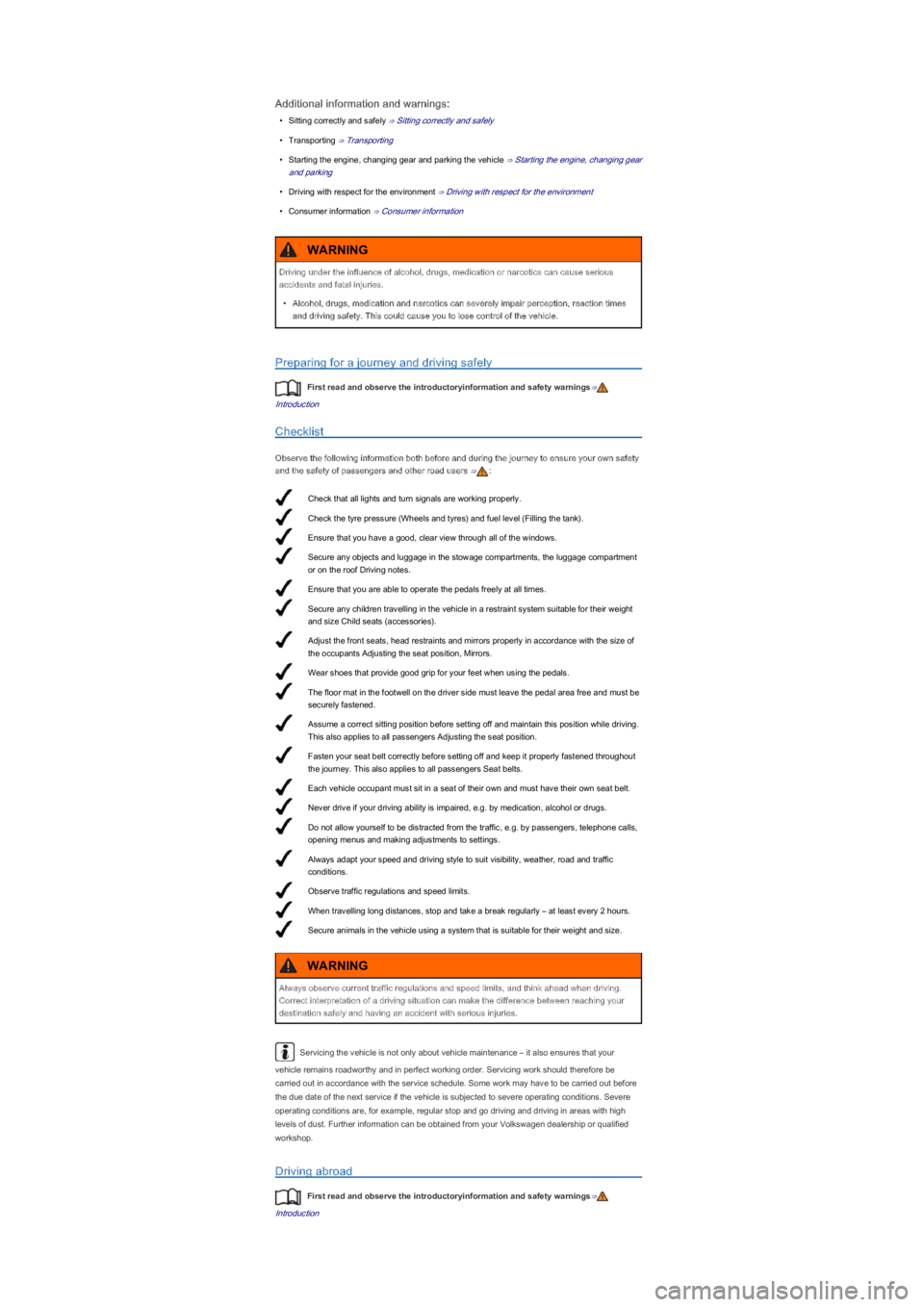
Check that all lights and turn signals are working properly.
Check the tyre pressure (Wheels and tyres) and fuel level (Filling the tank).
Ensure that you have a good, clear view through all of the windows.
Secure any objects and luggage in the stowage compartments, the luggage compartment
or on the roof Driving notes.
Ensure that you are able to operate the pedals freely at all times.
Secure any children travelling in the vehicle in a restraint system suitable for their weight
and size Child seats (accessories).
Adjust the front seats, head restraints and mirrors properly in accordance with the size of
the occupants Adjusting the seat position, Mirrors.
Wear shoes that provide good grip for your feet when using the pedals.
The floor mat in the footwell on the driver side must leave the pedal area free and must be
securely fastened.
Assume a correct sitting position before setting off and maintain this position while driving.
This also applies to all passengers Adjusting the seat position.
Fasten your seat belt correctly before setting off and keep it properly fastened throughout
the journey. This also applies to all passengers Seat belts.
Each vehicle occupant must sit in a seat of their own and must have their own seat belt.
Never drive if your driving ability is impaired, e.g. by medication, alcohol or drugs.
Do not allow yourself to be distracted from the traffic, e.g. by passengers, telephone calls,
opening menus and making adjustments to settings.
Always adapt your speed and driving style to suit visibility, weather, road and traffic
conditions.
Observe traffic regulations and speed limits.
When travelling long distances, stop and take a break regularly – at least every 2 hours.
Secure animals in the vehicle using a system that is suitable for their weight and size.
Additional information and warnings:
•Sitting correctly and safely ⇒ Sitting correctly and safely
•Transporting ⇒ Transporting
•Starting the engine, changing gear and parking the vehicle ⇒ Starting the engine, changing gear
and parking
•Driving with respect for the environment ⇒ Driving with respect for the environment
•Consumer information ⇒ Consumer information
Preparing for a journey and driving safely
First read and observe the introductoryinformation and safety warnings⇒
Introduction
Checklist
Observe the following information both before and during the journey to ensure your own safety
and the safety of passengers and other road users ⇒:
Servicing the vehicle is not only about vehicle maintenance – it also ensures that your
vehicle remains roadworthy and in perfect working order. Servicing work should therefore be
carried out in accordance with the service schedule. Some work may have to be carried out before
the due date of the next service if the vehicle is subjected to severe operating conditions. Severe
operating conditions are, for example, regular stop and go driving and driving in areas with high
levels of dust. Further information can be obtained from your Volkswagen dealership or qualified
workshop.
Driving abroad
First read and observe the introductoryinformation and safety warnings⇒
Introduction
Driving under the influence of alcohol, drugs, medication or narcotics can cause serious
accidents and fatal injuries.
•Alcohol, drugs, medication and narcotics can severely impair perception, reaction times
and driving safety. This could cause you to lose control of the vehicle.
WARNING
Always observe current traffic regulations and speed limits, and think ahead when driving.
Correct interpretation of a driving situation can make the difference between reaching your
destination safely and having an accident with serious injuries.
WARNING
Page 35 of 211
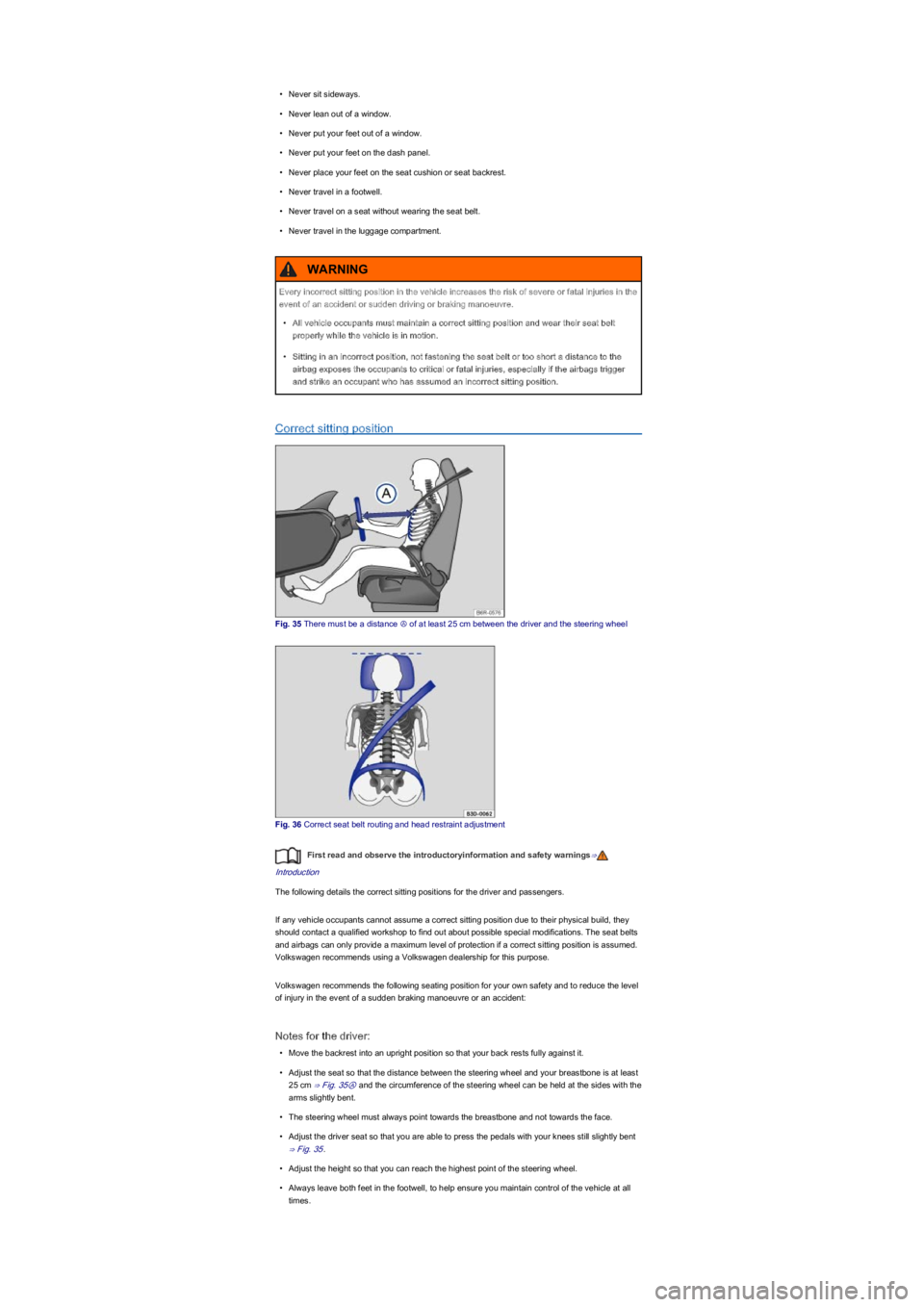
•Never sit sideways.
•Never lean out of a window.
•Never put your feet out of a window.
•Never put your feet on the dash panel.
•Never place your feet on the seat cushion or seat backrest.
•Never travel in a footwell.
•Never travel on a seat without wearing the seat belt.
•Never travel in the luggage compartment.
Correct sitting position
Fig. 35 There must be a distance Ⓐ of at least 25 cm between the driver and the steering wheel
Fig. 36 Correct seat belt routing and head restraint adjustment
First read and observe the introductoryinformation and safety warnings⇒
Introduction
The following details the correct sitting positions for the driver and passengers.
If any vehicle occupants cannot assume a correct sitting position due to their physical build, they
should contact a qualified workshop to find out about possible special modifications. The seat belts
and airbags can only provide a maximum level of protection if a correct sitting position is assumed.
Volkswagen recommends using a Volkswagen dealership for this purpose.
Volkswagen recommends the following seating position for your own safety and to reduce the level
of injury in the event of a sudden braking manoeuvre or an accident:
Notes for the driver:
•Move the backrest into an upright position so that your back rests fully against it.
•Adjust the seat so that the distance between the steering wheel and your breastbone is at least
25 cm ⇒ Fig. 35Ⓐ and the circumference of the steering wheel can be held at the sides with the
arms slightly bent.
•The steering wheel must always point towards the breastbone and not towards the face.
•Adjust the driver seat so that you are able to press the pedals with your knees still slightly bent
⇒ Fig. 35.
•Adjust the height so that you can reach the highest point of the steering wheel.
•Always leave both feet in the footwell, to help ensure you maintain control of the vehicle at all
times.
Every incorrect sitting position in the vehicle increases the risk of severe or fatal injuries in the
event of an accident or sudden driving or braking manoeuvre.
•All vehicle occupants must maintain a correct sitting position and wear their seat belt
properly while the vehicle is in motion.
•Sitting in an incorrect position, not fastening the seat belt or too short a distance to the
airbag exposes the occupants to critical or fatal injuries, especially if the airbags trigger
and strike an occupant who has assumed an incorrect sitting position.
WARNING
Page 38 of 211
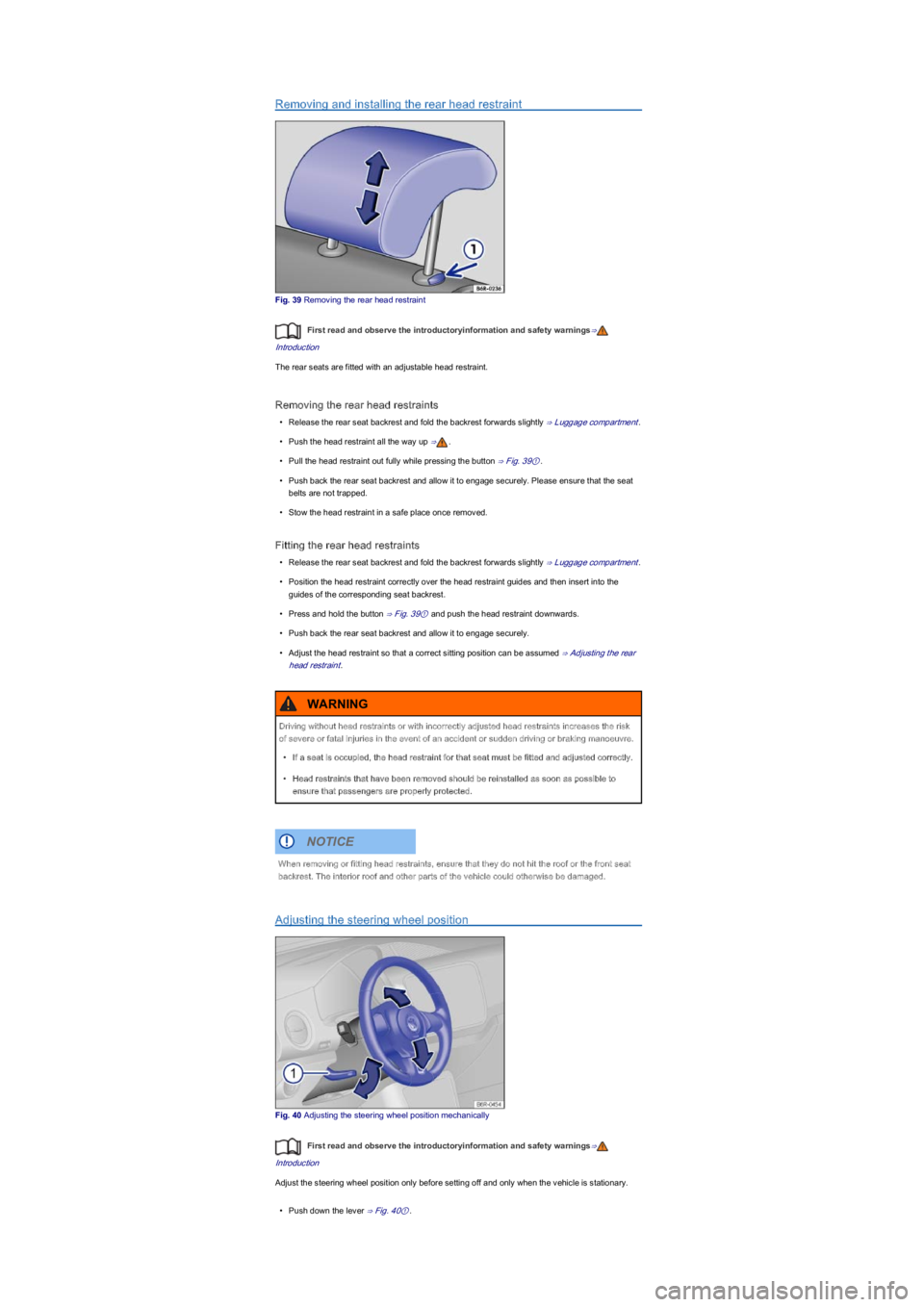
Removing and installing the rear head restraint
Fig. 39 Removing the rear head restraint
First read and observe the introductoryinformation and safety warnings⇒
Introduction
The rear seats are fitted with an adjustable head restraint.
Removing the rear head restraints
•Release the rear seat backrest and fold the backrest forwards slightly ⇒ Luggage compartment.
•Push the head restraint all the way up ⇒.
•Pull the head restraint out fully while pressing the button ⇒ Fig. 39①.
•Push back the rear seat backrest and allow it to engage securely. Please ensure that the seat
belts are not trapped.
•Stow the head restraint in a safe place once removed.
Fitting the rear head restraints
•Release the rear seat backrest and fold the backrest forwards slightly ⇒ Luggage compartment.
•Position the head restraint correctly over the head restraint guides and then insert into the
guides of the corresponding seat backrest.
•Press and hold the button ⇒ Fig. 39① and push the head restraint downwards.
•Push back the rear seat backrest and allow it to engage securely.
•Adjust the head restraint so that a correct sitting position can be assumed ⇒ Adjusting the rear
head restraint.
Adjusting the steering wheel position
Fig. 40 Adjusting the steering wheel position mechanically
First read and observe the introductoryinformation and safety warnings⇒
Introduction
Adjust the steering wheel position only before setting off and only when the vehicle is stationary.
•Push down the lever ⇒ Fig. 40①.
Driving without head restraints or with incorrectly adjusted head restraints increases the risk
of severe or fatal injuries in the event of an accident or sudden driving or braking manoeuvre.
•If a seat is occupied, the head restraint for that seat must be fitted and adjusted correctly.
•Head restraints that have been removed should be reinstalled as soon as possible to
ensure that passengers are properly protected.
WARNING
When removing or fitting head restraints, ensure that they do not hit the roof or the front seat
backrest. The interior roof and other parts of the vehicle could otherwise be damaged.
NOTICE
Page 39 of 211
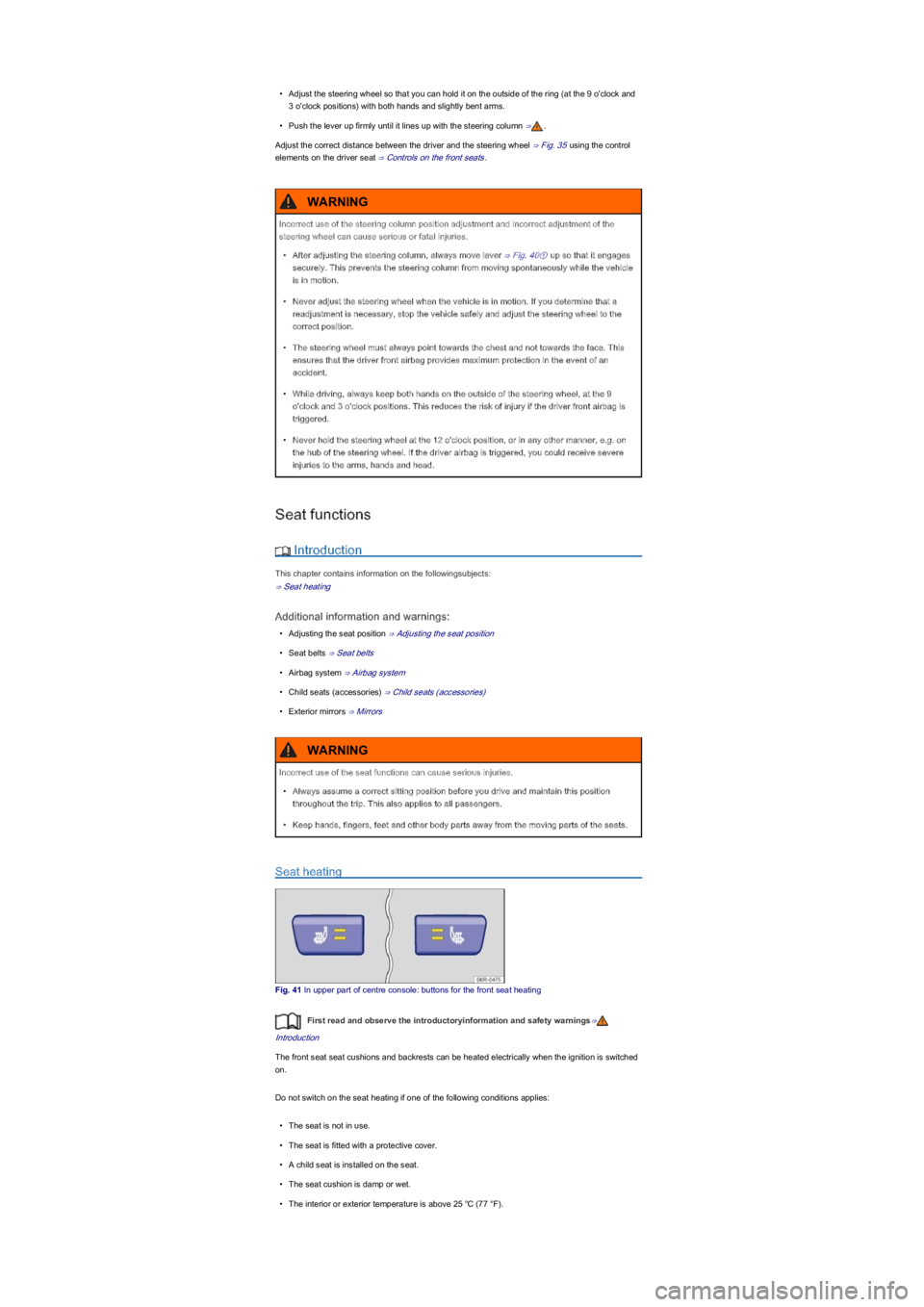
•Adjust the steering wheel so that you can hold it on the outside of the ring (at the 9 o'clock and
3 o'clock positions) with both hands and slightly bent arms.
•Push the lever up firmly until it lines up with the steering column ⇒.
Adjust the correct distance between the driver and the steering wheel ⇒ Fig. 35 using the control
elements on the driver seat ⇒ Controls on the front seats.
Seat functions
Introduction
This chapter contains information on the followingsubjects:
⇒ Seat heating
Additional information and warnings:
•Adjusting the seat position ⇒ Adjusting the seat position
•Seat belts ⇒ Seat belts
•Airbag system ⇒ Airbag system
•Child seats (accessories) ⇒ Child seats (accessories)
•Exterior mirrors ⇒ Mirrors
Seat heating
Fig. 41 In upper part of centre console: buttons for the front seat heating
First read and observe the introductoryinformation and safety warnings⇒
Introduction
The front seat seat cushions and backrests can be heated electrically when the ignition is switched
on.
Do not switch on the seat heating if one of the following conditions applies:
•The seat is not in use.
•The seat is fitted with a protective cover.
•A child seat is installed on the seat.
•The seat cushion is damp or wet.
•The interior or exterior temperature is above 25 ℃ (77 °F).
Incorrect use of the steering column position adjustment and incorrect adjustment of the
steering wheel can cause serious or fatal injuries.
•After adjusting the steering column, always move lever ⇒ Fig. 40① up so that it engages
securely. This prevents the steering column from moving spontaneously while the vehicle
is in motion.
•Never adjust the steering wheel when the vehicle is in motion. If you determine that a
readjustment is necessary, stop the vehicle safely and adjust the steering wheel to the
correct position.
•The steering wheel must always point towards the chest and not towards the face. This
ensures that the driver front airbag provides maximum protection in the event of an
accident.
•While driving, always keep both hands on the outside of the steering wheel, at the 9
o'clock and 3 o'clock positions. This reduces the risk of injury if the driver front airbag is
triggered.
•Never hold the steering wheel at the 12 o'clock position, or in any other manner, e.g. on
the hub of the steering wheel. If the driver airbag is triggered, you could receive severe
injuries to the arms, hands and head.
WARNING
Incorrect use of the seat functions can cause serious injuries.
•Always assume a correct sitting position before you drive and maintain this position
throughout the trip. This also applies to all passengers.
•Keep hands, fingers, feet and other body parts away from the moving parts of the seats.
WARNING
Page 40 of 211
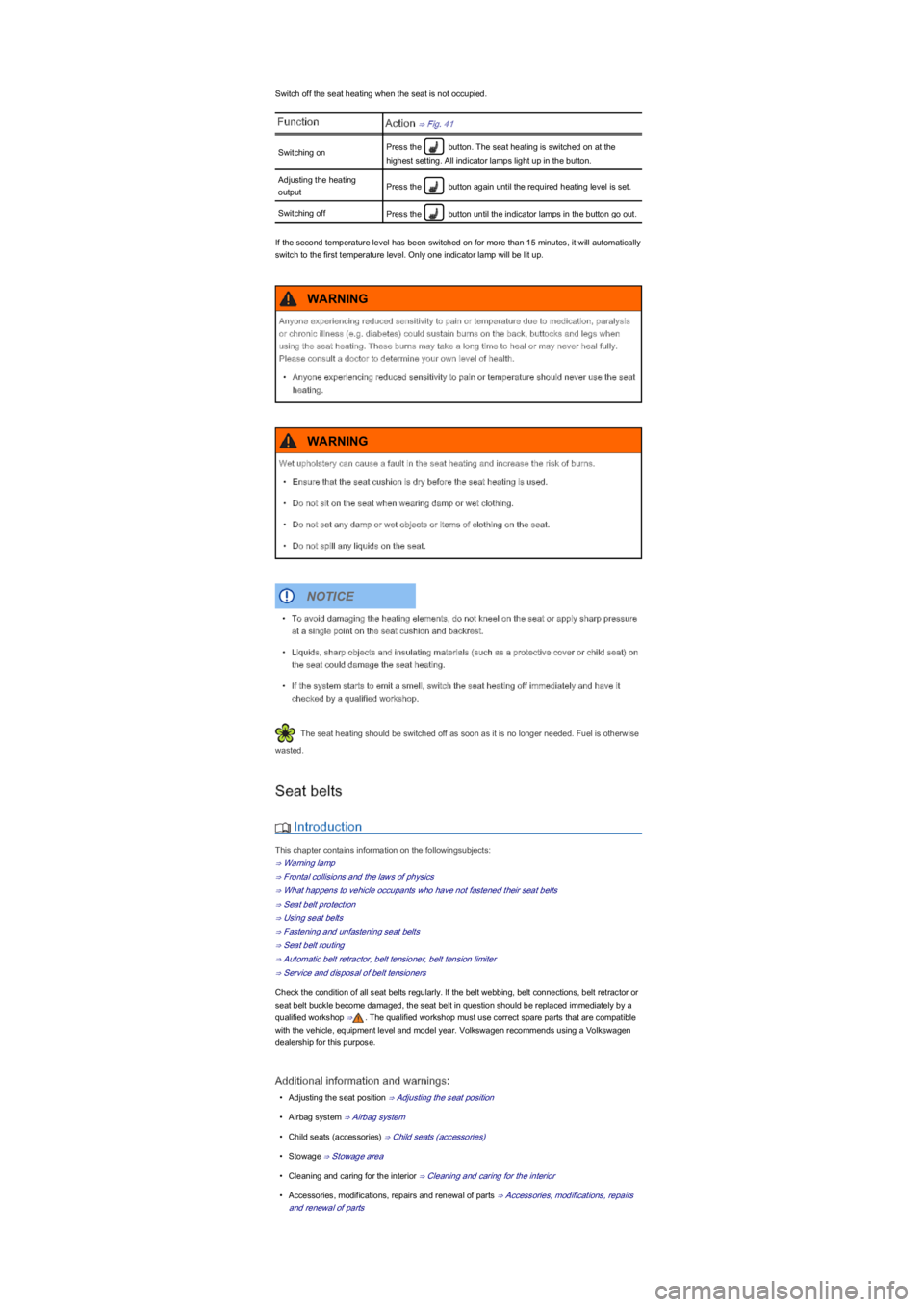
Switch off the seat heating when the seat is not occupied.
FunctionAction ⇒ Fig. 41
Switching onPress the button. The seat heating is switched on at the
highest setting. All indicator lamps light up in the button.
Adjusting the heating
outputPress the button again until the required heating level is set.
Switching offPress the button until the indicator lamps in the button go out.
If the second temperature level has been switched on for more than 15 minutes, it will automatically
switch to the first temperature level. Only one indicator lamp will be lit up.
The seat heating should be switched off as soon as it is no longer needed. Fuel is otherwise
wasted.
Seat belts
Introduction
This chapter contains information on the followingsubjects:
⇒ Warning lamp
⇒ Frontal collisions and the laws of physics
⇒ What happens to vehicle occupants who have not fastened their seat belts
⇒ Seat belt protection
⇒ Using seat belts
⇒ Fastening and unfastening seat belts
⇒ Seat belt routing
⇒ Automatic belt retractor, belt tensioner, belt tension limiter
⇒ Service and disposal of belt tensioners
Check the condition of all seat belts regularly. If the belt webbing, belt connections, belt retractor or
seat belt buckle become damaged, the seat belt in question should be replaced immediately by a
qualified workshop ⇒. The qualified workshop must use correct spare parts that are compatible
with the vehicle, equipment level and model year. Volkswagen recommends using a Volkswagen
dealership for this purpose.
Additional information and warnings:
•Adjusting the seat position ⇒ Adjusting the seat position
•Airbag system ⇒ Airbag system
•Child seats (accessories) ⇒ Child seats (accessories)
•Stowage ⇒ Stowage area
•Cleaning and caring for the interior ⇒ Cleaning and caring for the interior
•Accessories, modifications, repairs and renewal of parts ⇒ Accessories, modifications, repairs
and renewal of parts
Anyone experiencing reduced sensitivity to pain or temperature due to medication, paralysis
or chronic illness (e.g. diabetes) could sustain burns on the back, buttocks and legs when
using the seat heating. These burns may take a long time to heal or may never heal fully.
Please consult a doctor to determine your own level of health.
•Anyone experiencing reduced sensitivity to pain or temperature should never use the seat
heating.
WARNING
Wet upholstery can cause a fault in the seat heating and increase the risk of burns.
•Ensure that the seat cushion is dry before the seat heating is used.
•Do not sit on the seat when wearing damp or wet clothing.
•Do not set any damp or wet objects or items of clothing on the seat.
•Do not spill any liquids on the seat.
WARNING
•To avoid damaging the heating elements, do not kneel on the seat or apply sharp pressure
at a single point on the seat cushion and backrest.
•Liquids, sharp objects and insulating materials (such as a protective cover or child seat) on
the seat could damage the seat heating.
•If the system starts to emit a smell, switch the seat heating off immediately and have it
checked by a qualified workshop.
NOTICE
Page 41 of 211
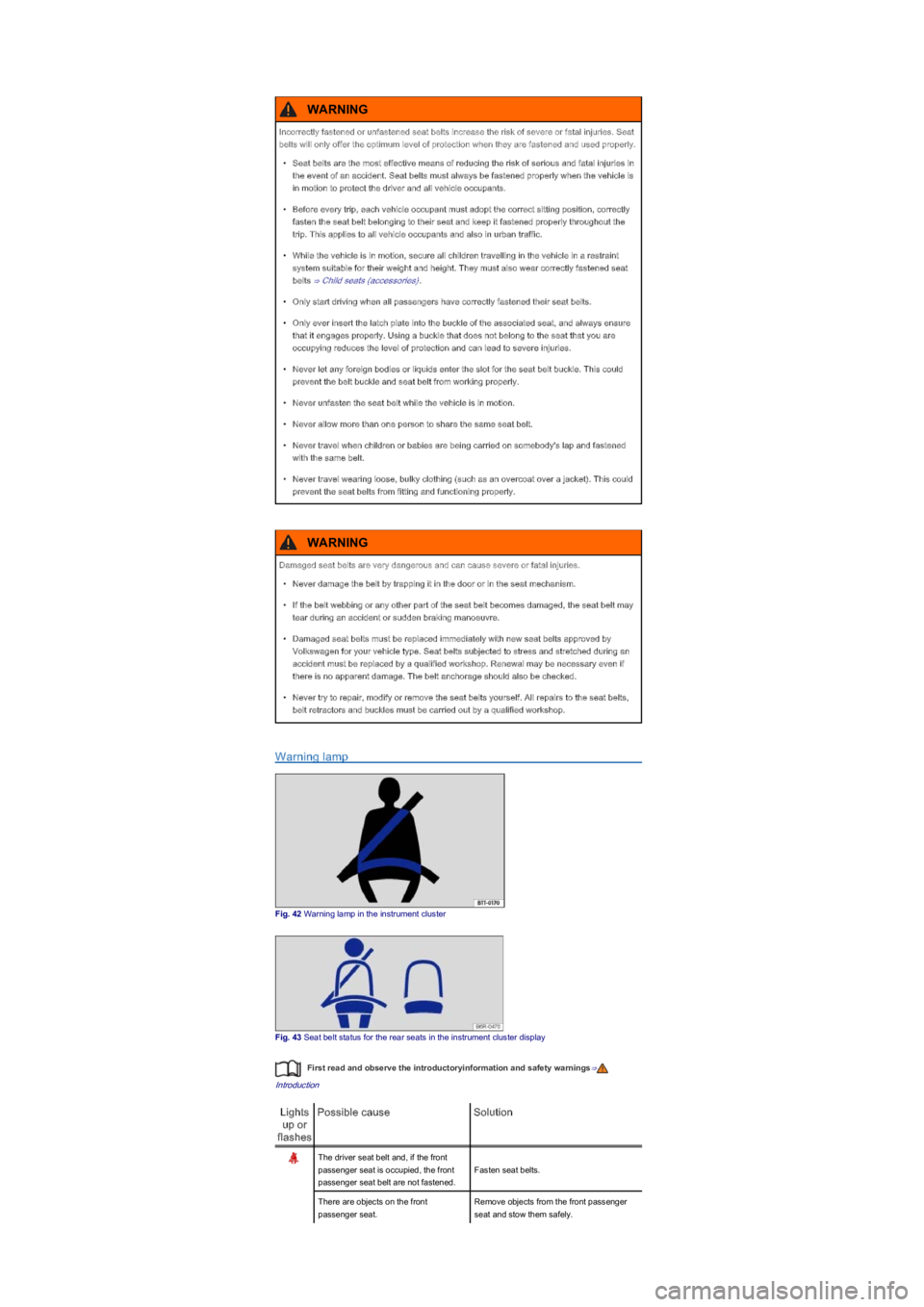
Warning lamp
Fig. 42 Warning lamp in the instrument cluster
Fig. 43 Seat belt status for the rear seats in the instrument cluster display
First read and observe the introductoryinformation and safety warnings⇒
Introduction
Lights
up or
flashes
Possible causeSolution
The driver seat belt and, if the front
passenger seat is occupied, the front
passenger seat belt are not fastened.
Fasten seat belts.
There are objects on the front
passenger seat.
Remove objects from the front passenger
seat and stow them safely.
Incorrectly fastened or unfastened seat belts increase the risk of severe or fatal injuries. Seat
belts will only offer the optimum level of protection when they are fastened and used properly.
•Seat belts are the most effective means of reducing the risk of serious and fatal injuries in
the event of an accident. Seat belts must always be fastened properly when the vehicle is
in motion to protect the driver and all vehicle occupants.
•Before every trip, each vehicle occupant must adopt the correct sitting position, correctly
fasten the seat belt belonging to their seat and keep it fastened properly throughout the
trip. This applies to all vehicle occupants and also in urban traffic.
•While the vehicle is in motion, secure all children travelling in the vehicle in a restraint
system suitable for their weight and height. They must also wear correctly fastened seat
belts ⇒ Child seats (accessories).
•Only start driving when all passengers have correctly fastened their seat belts.
•Only ever insert the latch plate into the buckle of the associated seat, and always ensure
that it engages properly. Using a buckle that does not belong to the seat that you are
occupying reduces the level of protection and can lead to severe injuries.
•Never let any foreign bodies or liquids enter the slot for the seat belt buckle. This could
prevent the belt buckle and seat belt from working properly.
•Never unfasten the seat belt while the vehicle is in motion.
•Never allow more than one person to share the same seat belt.
•Never travel when children or babies are being carried on somebody's lap and fastened
with the same belt.
•Never travel wearing loose, bulky clothing (such as an overcoat over a jacket). This could
prevent the seat belts from fitting and functioning properly.
WARNING
Damaged seat belts are very dangerous and can cause severe or fatal injuries.
•Never damage the belt by trapping it in the door or in the seat mechanism.
•If the belt webbing or any other part of the seat belt becomes damaged, the seat belt may
tear during an accident or sudden braking manoeuvre.
•Damaged seat belts must be replaced immediately with new seat belts approved by
Volkswagen for your vehicle type. Seat belts subjected to stress and stretched during an
accident must be replaced by a qualified workshop. Renewal may be necessary even if
there is no apparent damage. The belt anchorage should also be checked.
•Never try to repair, modify or remove the seat belts yourself. All repairs to the seat belts,
belt retractors and buckles must be carried out by a qualified workshop.
WARNING